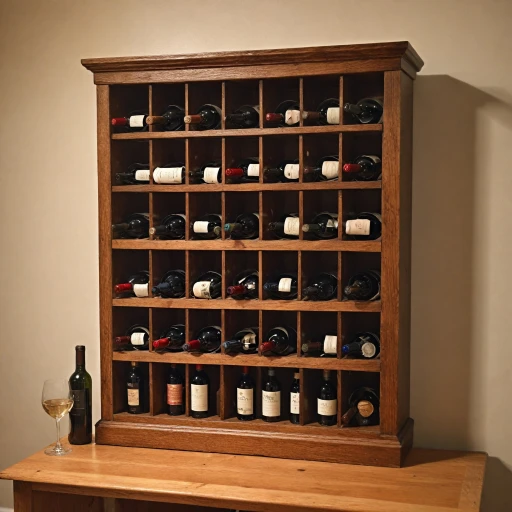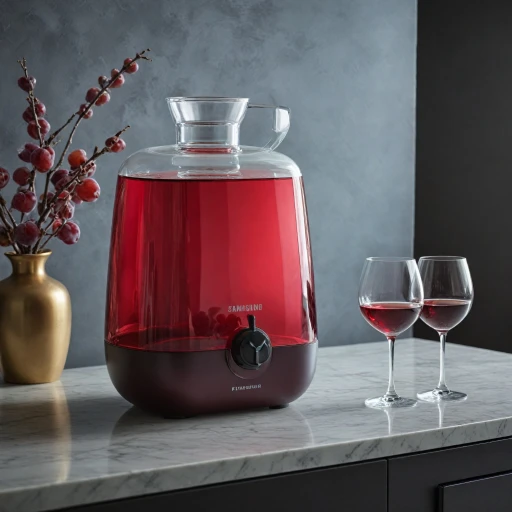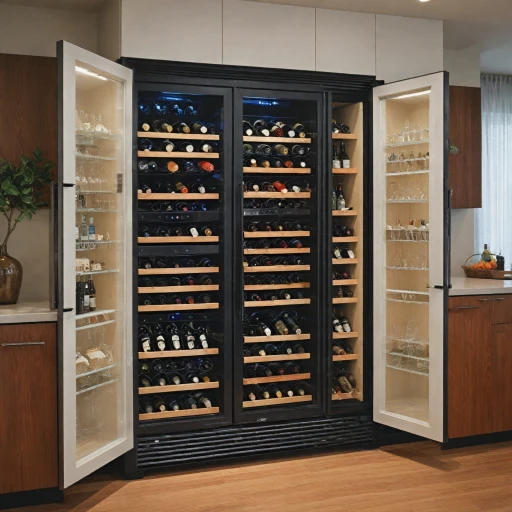
Understanding the Purpose of a Wine Aerator
Unlocking the Art of Wine Aeration
In the world of wine enthusiasts, aeration plays a pivotal role in enhancing the tasting experience. A wine aerator is an essential tool designed to expose wine to oxygen, allowing it to "breathe". This process can significantly elevate the flavors and aromas of a wine, particularly red wines that are known for their complex structures.
The key to understanding an aerator's purpose lies in its ability to soften tannins, bringing out a red wine's best qualities and rounding out the bouquet. This is crucial not only for wine aficionados but also for casual drinkers who wish to explore the full spectrum of a wine's profile—from delicate florals to robust earthy tones.
For those new to the world of wine aeration, selecting the right aerator can make all the difference. Options range from simple pourers to sophisticated electric models. Each type has its unique set of benefits, such as convenience and enhanced exposure to air. Additionally, the materials, such as stainless steel or material plastic, can affect the aerator's performance and ease of use.
It is essential to be mindful of common mistakes such as over-aerating or selecting the inappropriate style for specific wines. Some wines, like delicate red or dry wines, may require precise aeration to maintain their integrity.
For a deeper understanding of how aerators can elevate your wine sampling experiences, consider exploring our comprehensive guide.
Types of Wine Aerators and Their Benefits
Exploring Different Styles for Ideal Pairings
Delving into the world of wine aerators opens up various ideal presents for wine enthusiasts who are keen on enhancing their wine experience. Each style of aerator is tailored to unique needs, from casual sipping to more refined tasting sessions.
- Pourer Aerators: These often attach directly to the wine bottle and perform dual tasks of pouring and aerating in one go. Economical and user-friendly, they're commonly made of materials like stainless steel or material plastic. The design focuses on ease and efficiency, albeit with a bit less aeration compared to other types.
- Decanter Aerators: For more dedicated wine lovers, the use of a wine decanter styled with an aerator can subtly influence the flavors. They're known for handling red wines or dry vintages with grace, allowing wines to breathe properly. Though bulkier and at a higher price point, they are the best for those who appreciate full-bodied reds.
- Vinturi Aerators: This brand of aerators stands out with its specific design aimed at enhancing the taste and aroma of both young and aged bottles. Often seen as the top choice, the Vinturi wine aerators are as seamless in their function as they are stylish.
- Coravin Timeless Aerators: Perfect for those who wish to taste without opening the entire bottle, the Coravin system marries convenience with innovation. It's ideal for collectors who pour a glass here and there without affecting the bottle wine's integrity.
Each type of aerator brings its own set of advantages and unique flair to the table. From enhancing the smoothness of wine to ensuring the utmost flavor enrichment, choosing the right aerator can elevate a wine enthusiast's experience. Moreover, by making the right selection, one avoids common pitfalls and ensures longevity and easy clean maintenance of the tool.
How to Use a Wine Aerator Effectively
Optimizing Your Aerator Usage
Using a wine aerator effectively can significantly enhance your drinking experience, whether you're planning a quiet evening with a glass of red wine or hosting a tasting event that involves multiple aerators for different wines. Understanding the mechanics behind aeration ensures you extract the best aromas and flavors no matter the material of your aerator, be it stainless steel or material plastic.- Selecting the right vessel: Start by considering your wine — a broad-spectrum aerator pourer might work best for most reds. However, a more specific model like the Vinturi wine aerator or a wine decanter might reveal the nuances of particularly dry wines.
- Proper aeration method: Pour directly into the aerator at a steady pace to maximize oxygen exposure. For a markedly enhanced experience, opt for a strong aerator fitting over the wine bottle.
- Timing is everything: While red wines generally benefit from more air, be careful with lighter wines, where excessive aeration can strip away delicate notes. A quick pour using a coravin or utilizing features like a Coravin Timeless can be beneficial.
- Balancing cost and quality: When considering price, remember that a top-tier aerator can elevate even a standard bottle of wine to new heights. However, many of the best-selling aerators offer significant benefits without the high sale price.
- Additional utility: Some wine aerators double as whiskey spirits aerators, improving notes in your finer bottles of whiskey just as effectively as they do wine.
Comparing Wine Aerators: What to Look For
Factors to Consider When Selecting Your Wine Aerator
Choosing the right wine aerator can enhance your wine experience remarkably. The market is flooded with a variety of options, each boasting unique features. Understanding key factors can help in making an informed decision and ensure you get the best wine aerator for your needs.- Material and Build: Consider the material used in manufacturing the aerator. Common materials include stainless steel and plastic. Stainless steel often offers durability and a sleek appearance, while material plastic can be light and easy to handle. The choice largely depends on personal preferences and budget.
- Type of Wine: Red wines generally benefit the most from aeration, especially the robust and dry varieties. Brands like Vinturi and Coravin timeless are popular for aerating red wine. However, some wines and whiskey spirits may require minimal aeration.
- Ease of Use: Look for aerators that are simple to attach to the wine bottle or glass. An aerator pourer that fits snugly on the wine bottle with an easy clean design can be convenient. The best selling models often emphasize usability and minimal spillage.
- Price and Reviews: Conducting a price review can reveal the best options within your budget. Sale price is always attractive, but don't overlook product quality. Checking customer feedback and expert reviews can offer valuable insights into an aerator's performance.
- Additional Features: Some aerators come with complementary features, like built-in decanters or cart storage options. These multi-functional tools can add value by making the process more seamless.
Common Mistakes When Using a Wine Aerator
{Key Errors to Avoid When Using a Wine Aerator
A wine aerator can indeed enhance your wine-tasting experience, but only if used correctly. Missteps during the process could lead to unfavorable results. Here are common mistakes to watch out for:
- Rushing the Aeration Process: Aerating red wines, especially dry reds, is a practice that requires patience. Pouring the wine too quickly through the aerator might not provide enough exposure to air, thus not fully enhancing its flavors. Whether you opt for a Vinturi, Coravin, or any other wine aerator, allow ample time for air infusion.
- Ignoring Cleaning After Use: Proper wine aerator maintenance and care are critical to ensuring continued optimal performance. Residue left in an aerator pourer can alter the taste of future pours. Many wine aerators, like those made of stainless steel or material plastic, are designed for easy cleaning. Make it a habit to rinse your device after each use.
- Using the Wrong Aerator for Your Wine: Not all wines benefit equally from aeration, and a universal approach might not yield the best results. Some wines, like certain red wines or whiskey spirits, require specific types of aerators. Familiarize yourself with different types of aerators and their benefits to match the appropriate tool with the type of wine or whiskey bottle in use.
- Skipping Material Considerations: The material of the wine aerator can significantly impact the aeration results. While material plastic aerators tend to be more affordable, stainless steel options generally provide a more refined aeration process. Weigh the best combination of price and material to suit your preferences.
- Forgetting to Check for Reviews and Variations: As with any purchase decision, consulting reviews can guide you to select the best wine aerator for your needs. Remember, not all aerators are created equal, and some might be better suited for a particular bottle or glass of wine. From top-priced options to best-sellers often on sale price, the variations can be overwhelming, so informed decisions are crucial.
Wine Aerator Maintenance and Care
Ensuring Longevity and Performance
Proper maintenance of your wine aerator is key to enjoying the best wine experience over time. Whether you possess a sleek stainless steel model or a straightforward pourer crafted from material plastic, each type requires some specific care practices to extend its lifespan.
Firstly, after savoring a glass of red wine or whiskey spirits, it is essential to wash your wine aerator immediately. This helps to prevent wine and spirit residues from drying and clogging the aerator’s fine passages. Using warm, soapy water is generally effective for most aerators, including the popular vinturi wine model. However, always consult the product's specific care instructions, as some may recommend handwashing over dishwashers.
When dealing with more complex aerators, such as a coravin timeless or a multi-functional wine decanter, consider the material used in their construction. Some materials like glass or stainless steel lend themselves to easy clean methods, whereas more fragile models require gentle handling to avoid damage.
For wine enthusiasts eyeing new aerators, assessing reviews that highlight user experiences about ease of maintenance can be invaluable. Remember, the best wine aerator is not only about achieving perfect aeration but also being durable and simple to maintain. Therefore, checking the cart for features like easy disassembly can save you both time and effort.
Finally, avoid common pitfalls such as leaving aerators on red wines for extended periods or exposing them to high heat, which can degrade the material. With meticulous care, your aerator can enhance countless bottles of wine for years to come, providing both value for its price and optimal flavor results.












